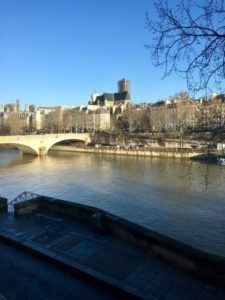By Bob Pratt, Class of 2019
Line 1 of the Paris subway begins its east-to-west run at the Chateau de Vincennes, a medieval castle featuring a 171 foot tower within expansive walled grounds, some 4.5 miles east of central Paris. It extends over 10 miles, ending six miles west of central Paris, beneath a planned development of skyscrapers and other buildings in an area outside the Paris city limits known as La Defense. Built upon a massive, mile-long pedestrian podium, La Defense features some twenty completed skyscrapers flanking its wide, wind-swept promenade, with a number of others under construction or planned, alongside mixed-use, low-rise buildings. The array creates an American-style skyline that many visitors to Paris see only from afar (peering west from the Arc de Triomphe). It is isolated and bounded, accommodating tall commercial and residential structures while keeping them far away from historic central Paris.
Napoleon III modernized Paris in the mid-19th Century by commissioning Baron Georges Haussmann to redesign much of the city with wide boulevards, parks, modern infrastructure, and grand Second Empire-style buildings, leaving untouched only a few neighborhoods (most prominently the Marais) in their medieval layouts. But by the 20th century, there was a limited appetite for further modernization, particularly any changes which might jeopardize the achievements of Haussmann or alter the character of the Marais. Official efforts in the 20th century focused on preserving Paris in its “City of Light” form and resisting construction of tall structures in the city. The 1973 completion of the much-reviled Tour Montparnasse, rising incongruously 689 feet above Paris’s Left Bank, prompted city leaders to enact, in 1977, strict building height restrictions within the city’s borders: 89 feet in the inner ring and 121 feet in the outer ring. The medieval tower at Vincennes, had it been within the city, would have been banned!
As Paris became increasingly restrictive, a relief valve for skyscrapers was opening west of the city. Efforts to develop Paris’s Axe historique (historical axis), beyond the Arc de Triomphe westward to the site of the Franco-Prussian war monument “La Defense de Paris,” began shortly after the end of World War I. Planning progressed haltingly through the 1930s, but eventually focused on the far-western end of the Triumphal Way—the La Defense area at the end of the axis. In 1958 a development agency was established, and in 1964 a plan for development was approved, calling for 20 office towers of 25 stories each.
The original height restrictions of 330 feet were removed entirely in 1972, enabling construction of a second and then third generation of skyscrapers, and cementing La Defense’s position as the home for skyscrapers in the Paris area. The tallest of the third generation is the renovated Tour First (SRA; Kohn Pedersen Fox 2007, 2011), now 758 feet high and the tallest inhabited building in the Paris area, surpassed only by the uninhabited Eiffel Tower.
La Defense continues to grow rapidly. As part of a 10-year plan originally scheduled to be completed in 2015, new and revolutionary skyscrapers are under construction, including France’s first supertall structures. The Hermitage Group’s twin 1,060-foot Hermitage Towers (Foster+Partners) at the gateway to La Defense are now expected to be completed in time for the 2024 Paris Olympics. They will be the tallest buildings in the European Union. Nearby, the 722-foot Hekla Tower (Jean Nouvel, est. 2020) will feature cutting-edge, energy-efficient designs including a thin and breathable double skin.

Many of France’s largest corporations are headquartered in La Defense, including Aventis, Total, Societe Generale, EDF, and AXA. Some 180,000 people work and 20,000 people live in this largest planned business district in Europe.
While history is preserved in Vincennes and nurtured within Paris itself, the modern and efficient physical infrastructure necessary for a growing economy takes shape in La Defense.







Bob
Enjoyed this very much as we visited La Defense when we were in Paris a few years ago. A must visit for architecture fans..
Donna